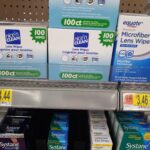
The good news: grocery inflation is on the decline and stores are offering more sales. The bad news: neither is happening fast enough for cost-conscious shoppers.
The newest report from Nielsen finds that price increases are slowing and promotions are becoming more prevalent. But while the “data shows some relief, shoppers are still grappling with high prices.” And more of those shoppers uninterested in regular prices and unimpressed by sale prices are switching brands, switching stores or just doing without.
Overall food and nonfood grocery prices last month were up 6.2%, which is half what it was just eight months ago and the lowest in nearly two years. But grocery inflation is “still well above the normal 2-3% range,” Nielsen noted.
Price increases are still being felt across the grocery store, led by an average 12% price increase in dry groceries, followed by a 10% increase in the bakery department, 9% in frozen food and 6% in the dairy section. When broken down by individual items, inflation is hitting hardest in insect sprays, with prices up 40%. Frozen potato products are up 36%, prices for rolls and buns are up 34% and 30%, respectively, and sliced ham prices are up 30%.
As a result, “consumers are spending more but purchasing fewer items,” which “is a worry for the industry,” Nielsen stated. More than a third of shoppers say they are focused only on buying essentials. Year-over-year, nonfood sales are down 5%, and even sales of food items are down by 2%.
When a must-have item is on the shopping list, and shoppers don’t like the price of their favorite brand at their favorite store, more shoppers are turning to cheaper alternatives. Store brand products now account for 19% of grocery spending, while “value retailers” like dollar stores and discounters now account for 42.3% of grocery sales.
So perhaps traditional grocery retailers can attract more shoppers with their traditional strategy of offering doorbuster deals?
It’s hard to believe today, but back in 2009 during the Great Recession, Nielsen reported that promotional sales approached 50% – meaning half of all grocery items sold, were sold at a promotional price. And coupon activity was way up at the time as well. These days, coupon use continues on a steady decline, and promotions are far from that historic peak. Promotional sales are rebounding from recent lows, now accounting for 26.6% of all grocery sales. While that’s 5 percentage points more than the low point in April 2020, it’s still 5 percentage points below the historical average.
Promotional sales “remain a key driver of growth,” Nielsen noted. But “retailers must avoid promoting too aggressively,” it warned, “as this is not a sustainable profit strategy. Promotions should be used purposefully to build brands, not to undermine loyalty.”
Try telling that to shoppers who’ve balked at higher prices, switched to lower-cost brands, and won’t come back unless they can get a deal.
One way or another, “manufacturers must continue to seek new drivers of growth as consumption continues to decline,” Nielsen concluded. “Americans are keenly aware of rising prices and have adapted their shopping habits accordingly, seeking ways to save and make their budgets stretch further.” And unless brands and retailers find a way to get them back, the longer that shoppers stick to their newly-found saving strategies – the more likely it is that those strategies may become permanent.
Image source: Virginia Retail















